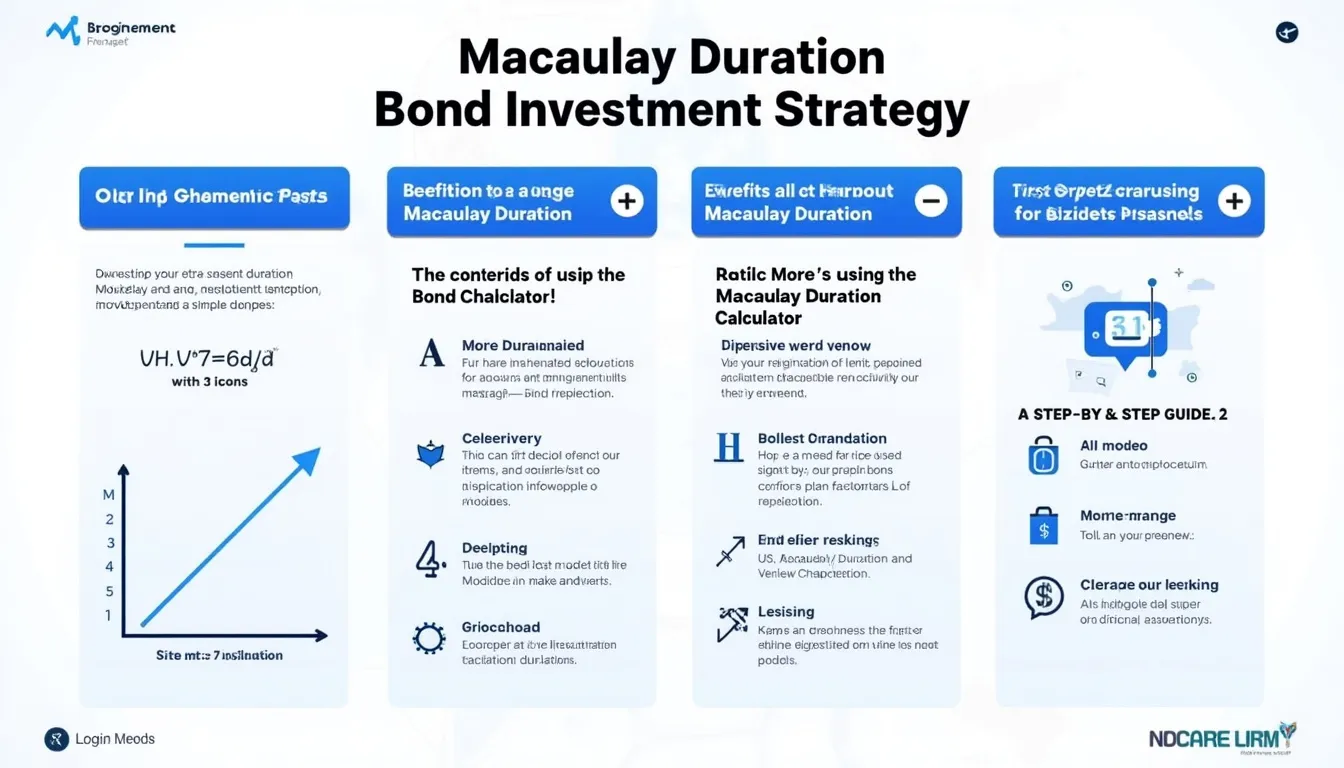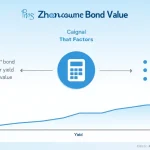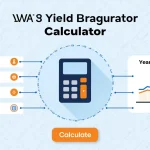Macaulay Duration Calculator
Is this tool helpful?
Macaulay Duration Calculator: Optimize Your Bond Investment Strategy
How to Use the Macaulay Duration Calculator Effectively
Our Macaulay Duration Calculator is designed to help investors, financial analysts, and bond enthusiasts accurately determine the weighted average time to receive the present value of a bond’s cash flows. Follow these simple steps to use the calculator effectively:
- Enter the Face Value of the Bond: Input the par value or face value of the bond in USD.
- Input the Coupon Rate: Enter the annual coupon rate as a decimal (e.g., 0.05 for 5%).
- Select the Maturity Date: Choose the date when the bond will mature.
- Choose the Coupon Frequency: Select how often coupon payments are made (annually, semi-annually, or quarterly).
- Enter the Discount Rate: Input the market yield or discount rate as a decimal.
- Calculate: Click the “Calculate” button to obtain the Macaulay Duration result.
Understanding Macaulay Duration: Definition, Purpose, and Benefits
Macaulay Duration, named after Frederick Macaulay who developed the concept in 1938, is a crucial metric in fixed-income investing. It measures the weighted average time until all cash flows from a bond are received, providing investors with valuable insights into bond price sensitivity and investment risk.
Definition
Macaulay Duration is defined as the weighted average term to maturity of the cash flows from a bond. It is expressed in years and represents the time it takes to recover the true cost of a bond, considering both the present value of future coupon payments and the principal.
Purpose
The primary purpose of calculating Macaulay Duration is to assess the interest rate risk of a bond or fixed-income portfolio. It helps investors understand how changes in interest rates might affect bond prices, enabling them to make informed decisions about their investment strategies.
Benefits
- Provides a single number to compare bonds with different maturities and coupon rates
- Helps in immunizing bond portfolios against interest rate risk
- Assists in yield curve analysis and bond pricing
- Facilitates better risk management in fixed-income investments
- Aids in the construction of bond ladders and portfolio optimization
The Mathematical Formula Behind Macaulay Duration
The Macaulay Duration is calculated using the following formula:
$$ D = \frac{\sum_{t=1}^{n} \frac{t \cdot C_t}{(1+r)^t}}{\sum_{t=1}^{n} \frac{C_t}{(1+r)^t}} $$Where:
- D = Macaulay Duration
- t = Time period
- Ct = Cash flow at time t
- r = Yield to maturity (discount rate)
- n = Total number of periods
Benefits of Using the Macaulay Duration Calculator
Our Macaulay Duration Calculator offers numerous advantages for investors and financial professionals:
- Time-saving: Quickly compute Macaulay Duration without complex manual calculations.
- Accuracy: Minimize human error and ensure precise results for better decision-making.
- Flexibility: Easily adjust input parameters to analyze various bond scenarios.
- Educational tool: Understand the relationship between bond characteristics and duration.
- Risk assessment: Evaluate interest rate sensitivity of bonds or bond portfolios.
- Portfolio management: Facilitate bond selection and portfolio construction strategies.
- Comparative analysis: Quickly compare durations of different bonds or portfolios.
Addressing User Needs: How the Macaulay Duration Calculator Solves Specific Problems
Our Macaulay Duration Calculator addresses several key challenges faced by investors and financial analysts:
1. Assessing Interest Rate Risk
Problem: Investors need to understand how changes in interest rates might affect their bond investments.
Solution: The calculator provides a clear measure of a bond’s sensitivity to interest rate changes. A higher Macaulay Duration indicates greater sensitivity, allowing investors to adjust their portfolios accordingly.
2. Comparing Bonds with Different Characteristics
Problem: It’s challenging to compare bonds with varying coupon rates, face values, and maturities.
Solution: Macaulay Duration offers a standardized metric for comparison, enabling investors to evaluate different bonds on a level playing field.
3. Portfolio Immunization
Problem: Investors need to protect their portfolios against interest rate fluctuations.
Solution: By calculating the Macaulay Duration of individual bonds, investors can construct portfolios with a target duration that matches their investment horizon, effectively immunizing against interest rate risk.
4. Yield Curve Analysis
Problem: Understanding how changes in the yield curve affect bond prices can be complex.
Solution: Macaulay Duration helps investors analyze the impact of yield curve shifts on bond prices, facilitating more informed investment decisions.
Practical Applications: Examples and Use Cases
Let’s explore some practical applications of the Macaulay Duration Calculator through examples:
Example 1: Comparing Two Bonds
Suppose an investor is considering two bonds:
- Bond A: $1,000 face value, 4% coupon rate, 5-year maturity, semi-annual payments
- Bond B: $1,000 face value, 6% coupon rate, 3-year maturity, annual payments
Assuming a discount rate of 5% for both bonds, we can use the calculator to determine their Macaulay Durations:
- Bond A Macaulay Duration: 4.55 years
- Bond B Macaulay Duration: 2.83 years
Interpretation: Bond A has a higher duration, indicating it’s more sensitive to interest rate changes. If the investor expects interest rates to fall, Bond A might be preferable as its price would increase more than Bond B’s. Conversely, if rates are expected to rise, Bond B might be a safer choice.
Example 2: Portfolio Immunization
An institutional investor has a liability due in 5 years and wants to immunize their portfolio against interest rate risk. They can use the Macaulay Duration Calculator to select bonds that, when combined, have an average duration of 5 years.
For instance, they might choose:
- 60% allocation to a bond with a duration of 4 years
- 40% allocation to a bond with a duration of 6.5 years
The weighted average duration would be: (0.6 * 4) + (0.4 * 6.5) = 5 years, matching their investment horizon and providing immunization against interest rate changes.
Example 3: Yield Curve Analysis
An analyst is studying the impact of a potential parallel shift in the yield curve. They calculate the Macaulay Duration for a 10-year bond with a 5% coupon rate, semi-annual payments, and a current yield of 4.5%:
Macaulay Duration: 8.36 years
If the yield curve shifts up by 0.5%, the analyst can estimate the bond’s price change using the approximation:
$$ \text{Price Change} \approx -\text{Duration} \times \text{Yield Change} $$Estimated price change: -8.36 * 0.005 = -0.0418 or -4.18%
This quick estimation helps the analyst understand the potential impact of yield curve shifts on bond prices without complex calculations.
Frequently Asked Questions (FAQ)
1. What is the difference between Macaulay Duration and Modified Duration?
Macaulay Duration measures the weighted average time to receive cash flows, while Modified Duration measures the price sensitivity of a bond to changes in interest rates. Modified Duration is derived from Macaulay Duration by dividing it by (1 + yield to maturity).
2. How does coupon rate affect Macaulay Duration?
Generally, bonds with higher coupon rates have shorter Macaulay Durations because a larger portion of the bond’s value is received earlier through coupon payments. Conversely, lower coupon rates result in longer durations.
3. Why is Macaulay Duration important for bond investors?
Macaulay Duration helps investors assess interest rate risk, compare bonds with different characteristics, and construct portfolios that match their investment horizons. It’s a crucial tool for risk management in fixed-income investing.
4. Can Macaulay Duration be negative?
No, Macaulay Duration cannot be negative. It represents a weighted average time, which is always positive for conventional bonds. However, for certain complex financial instruments, duration can theoretically be negative.
5. How often should I recalculate Macaulay Duration for my bond portfolio?
It’s advisable to recalculate Macaulay Duration periodically, especially when market conditions change significantly or when you make changes to your portfolio. Many investors recalculate quarterly or semi-annually, but more frequent calculations may be necessary in volatile markets.
6. Is a higher or lower Macaulay Duration better?
Neither is inherently better; it depends on your investment strategy and market expectations. Higher duration bonds are more sensitive to interest rate changes, offering greater potential returns but also higher risk. Lower duration bonds are less sensitive, providing more stability but potentially lower returns.
7. Can Macaulay Duration be used for stocks or other non-fixed income securities?
Macaulay Duration is primarily used for fixed-income securities like bonds. While similar concepts can be applied to other securities, such as dividend-paying stocks, the traditional Macaulay Duration calculation is not directly applicable to non-fixed income investments.
Please note that while we strive for accuracy and reliability, we cannot guarantee that our webtool or the results it provides are always correct, complete, or reliable. Our content and tools may contain errors, biases, or inconsistencies. Always consult with a qualified financial professional before making investment decisions.
Conclusion: Empowering Your Bond Investment Strategy
The Macaulay Duration Calculator is an invaluable tool for investors, financial analysts, and anyone involved in fixed-income markets. By providing a clear measure of a bond’s sensitivity to interest rate changes, it empowers users to make more informed investment decisions, manage risk effectively, and optimize their bond portfolios.
Key benefits of using our Macaulay Duration Calculator include:
- Quick and accurate calculations
- Enhanced understanding of bond characteristics
- Improved risk assessment and management
- Facilitation of portfolio immunization strategies
- Better comparison of bonds with different features
- Support for yield curve analysis and bond pricing
By incorporating Macaulay Duration into your investment analysis toolkit, you’ll be better equipped to navigate the complex world of fixed-income investing, make data-driven decisions, and potentially enhance your investment returns.
Take advantage of our user-friendly Macaulay Duration Calculator today and elevate your bond investment strategy to new heights. Whether you’re a seasoned professional or a novice investor, this powerful tool will provide valuable insights to support your financial goals.
Ready to optimize your bond investments? Start using our Macaulay Duration Calculator now and gain a competitive edge in the fixed-income market!
Important Disclaimer
The calculations, results, and content provided by our tools are not guaranteed to be accurate, complete, or reliable. Users are responsible for verifying and interpreting the results. Our content and tools may contain errors, biases, or inconsistencies. We reserve the right to save inputs and outputs from our tools for the purposes of error debugging, bias identification, and performance improvement. External companies providing AI models used in our tools may also save and process data in accordance with their own policies. By using our tools, you consent to this data collection and processing. We reserve the right to limit the usage of our tools based on current usability factors. By using our tools, you acknowledge that you have read, understood, and agreed to this disclaimer. You accept the inherent risks and limitations associated with the use of our tools and services.







